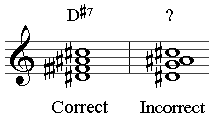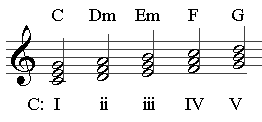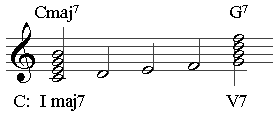Study Guide
Week 3
[ Reading ] [ Textbook ] [ New Material ] [ What You Should Know ] [ Homework ]
Textbook
Reading: pp. 62 - 70. The text introduces the idea of a "seventh chord" as being a triad with some sort of a seventh added. "Seventh" chords are four-note chords. They get their name from the interval of the extra note that is added to the triad.
Start by numbering the degrees of a major scale:

The major triad is then formed by stacking the 1st, 3rd, and 5th notes on top of each other:

The interval between the first and seventh note of a major scale is called a "major 7th", abbreviated "M7". Adding a major seventh above the root note to a major triad results in a "major seventh" chord.

When it calls the dominant seventh chord a "major-minor seventh" it means that there is a major triad on the bottom, with a minor 7th added on the top. We will use the term "dominant seventh" or "V7" chord instead.
What they call the "half-diminished seventh chord" we will call "minor seven, flat 5".
In our system, we learn how to form seventh chords by making alterations to the major seventh chord, built by combining the first, third, fifth, and seventh notes of the major scale. The other chords are formed by lowering pitches by half steps, indicated by the "-" sign. The 7sus chord is not mentioned in the text. It is the only chord that doesn't have a third in it.
major seventh
dominant seventh
seven, suspended 4th
minor seventh
minor seventh, flat fifth
diminished seventh
example
chord
symbolC maj 7
C7
C7sus
Cm7
Cm7(b5)
Co7
textbook name
major seventh: major seventh, major triad
major-minor seventh: minor seventh, major triad
(book does not cover) minor 7th: minor seventh, minor triad
half-diminished 7th: minor seventh, diminished triad
diminished 7th: diminished seventh, diminished triad
degrees
7
7
-7
-7
-7
-7
--7
5
5
5
5
5
-5
-5
3
3
3
4 (replaces 3)
-3
-3
-3
1
1
1
1
1
1
1
example
The examples above are seventh chords in C major.
It's important that you recognize the sound of these chords and how they are written in other keys.
The chapter goes on to talk about inversions, which we will get into more next week. The section about chromatically altered chords and the different types of sixth chords is meant for traditional theory courses and less important in popular music. We will get to ninth chords in the next course. Always review the summary information at the end of each chapter.
Turn in worksheet 30. You only have to complete the first two lines--the rest is in alto clef.
Do the exercises 8.1 and 8.2 using the Practica Musica software from the textbook.
Notice that in 8.2 you use a keyboard with split keys to allow you to specify the correct notes according to theoretical principles.
A root position chord can be quickly identified visually by seeing that it is built in thirds, either as all spaces or all lines stacked up:
All lines or all spaces
While enharmonic equivalents will sound the same, when writing chords you want to use the first-third-fifth-seventh note, etc., of the scale with any necessary alterations. A D#7 chord is therefore spelled D# F## (F double sharp) A# C#. Spelling the chord D#, G, A# C# might make it easier to find the notes on the keyboard, but it disguises the fact that it's a chord built on thirds above the D# root.
- When you're done, print out a copy of your progress report to turn in showing your name and scores.
Exercise Page in textbook Activity 8.1 66 recognizing seventh chords 8.2 69 building seventh chords Review
Review the triads from last lesson--it helps if you are comfortable with them before adding an additional note on top to form the seventh chord. You will be glad if you took the time already to brush up on key signatures and scales. If you haven't, now's the time! Seventh chords will be confusing if you don't know the notes of the major scales well, and then can't see what's being altered.
New Material
This week we add to the triad functions that we know. We have already seen the I, IV, and V chords, now we fill in the gaps with the ii and iii chords. I, IV, and V are always major. ii and iii are always minor. You should start to become familiar with these five chords in chord progressions. In the key of C major the first five chords are as follows:
We also see our first seventh chords, beginning with the I maj7 and V7 chords:
Learn both ways of constructing seventh chords, by types of triads and sevenths, and by degree alteration. Start to become familiar with the sound.
What You Should Know
At the end of this week you should be able to:
construct and identify major 7, and 7 (dominant 7)
recognize and differentiate the sounds of the five types of triads presented last week, and the two seventh chords from this week: the major7 and 7.
Homework
See the homework assignment. Like every week, the homework will be due at the Friday of the following week, in other words, NEXT FRIDAY. The homework assignment is summarized on the class schedule, but the assignment page is the final authority and goes into greater detail.
©2001 Robert Willey








